|
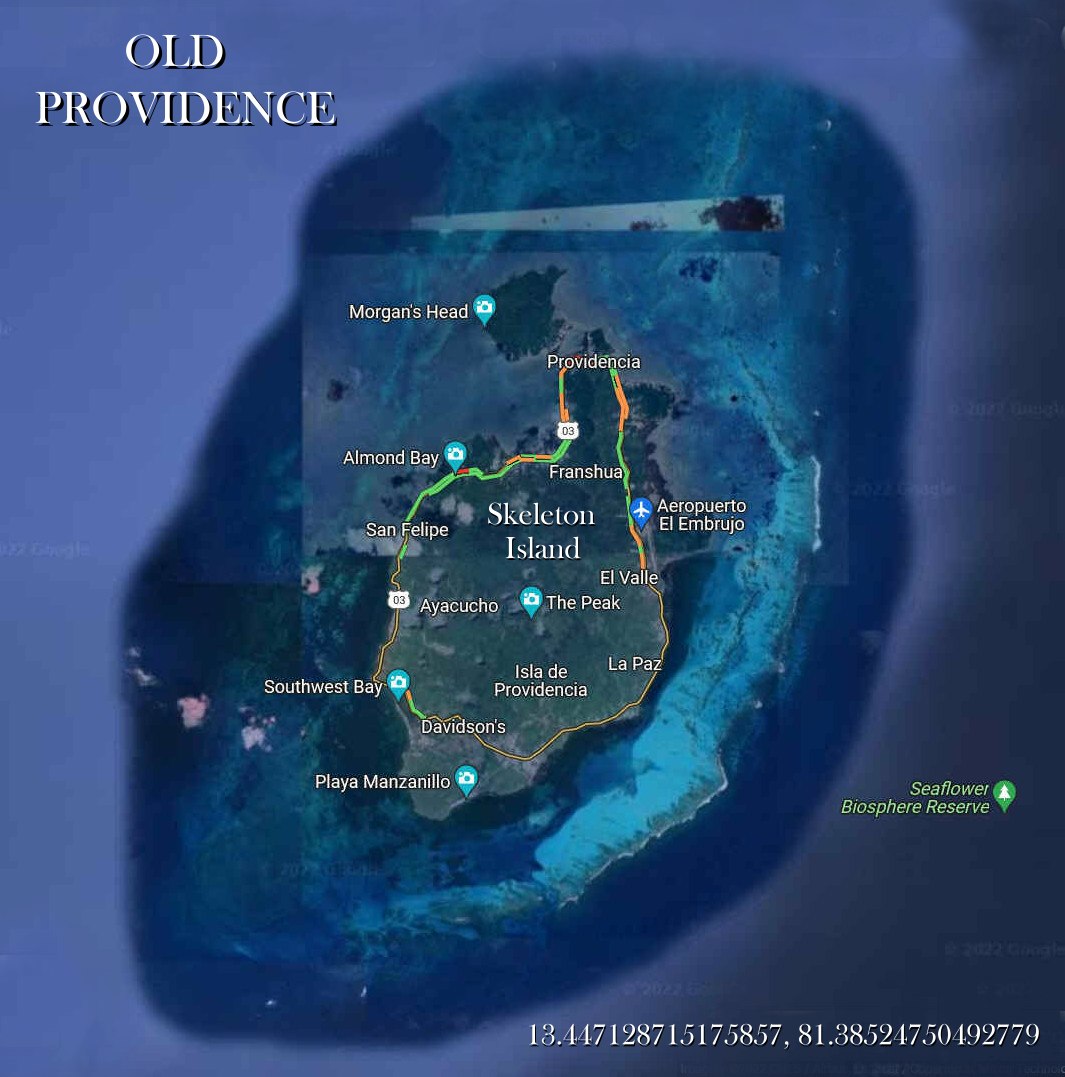
ISLA
DE PROVIDENCIA - 13.447128715175857, -81.38524750492779 (Mosquito Coast)
The Caribbean
Sea is littered with shipwrecks and dozens of paradise
islands, where
pirates
might have buried their treasure. But there are few clues as to where the
hundreds of privateers may have ventured, and where such errands may have proved
onerous to lesser mortals, let alone the treasure hunters that followed,
hoping to make an easy fortune. Hence, are typically discounted as being a
realistic proposition. But some pirates are made of sterner stuff.
Determined to prevent their slave trading masters from gaining yet further
easy riches. Just about all colonial efforts were based on exploiting less
fortunate souls, ignoring the moral dilemma, most of us would face today,
where human rights, fundamental freedoms are spreading across the globe,
following the atrocities in World
War Two.
Old
Providence, as it was known then, was some 700 kilometers off the pirate sailing
highways, too near Columbia for comfort for most pirates to consider nesting
their eggs. With the Spanish controlling these waters and very active in
protecting the region some 300 years ago, and rival nations: Columbia, Cuba
and Mexico, patrolling their territorial waters today. Looking out for
smuggling operations and military interventions.
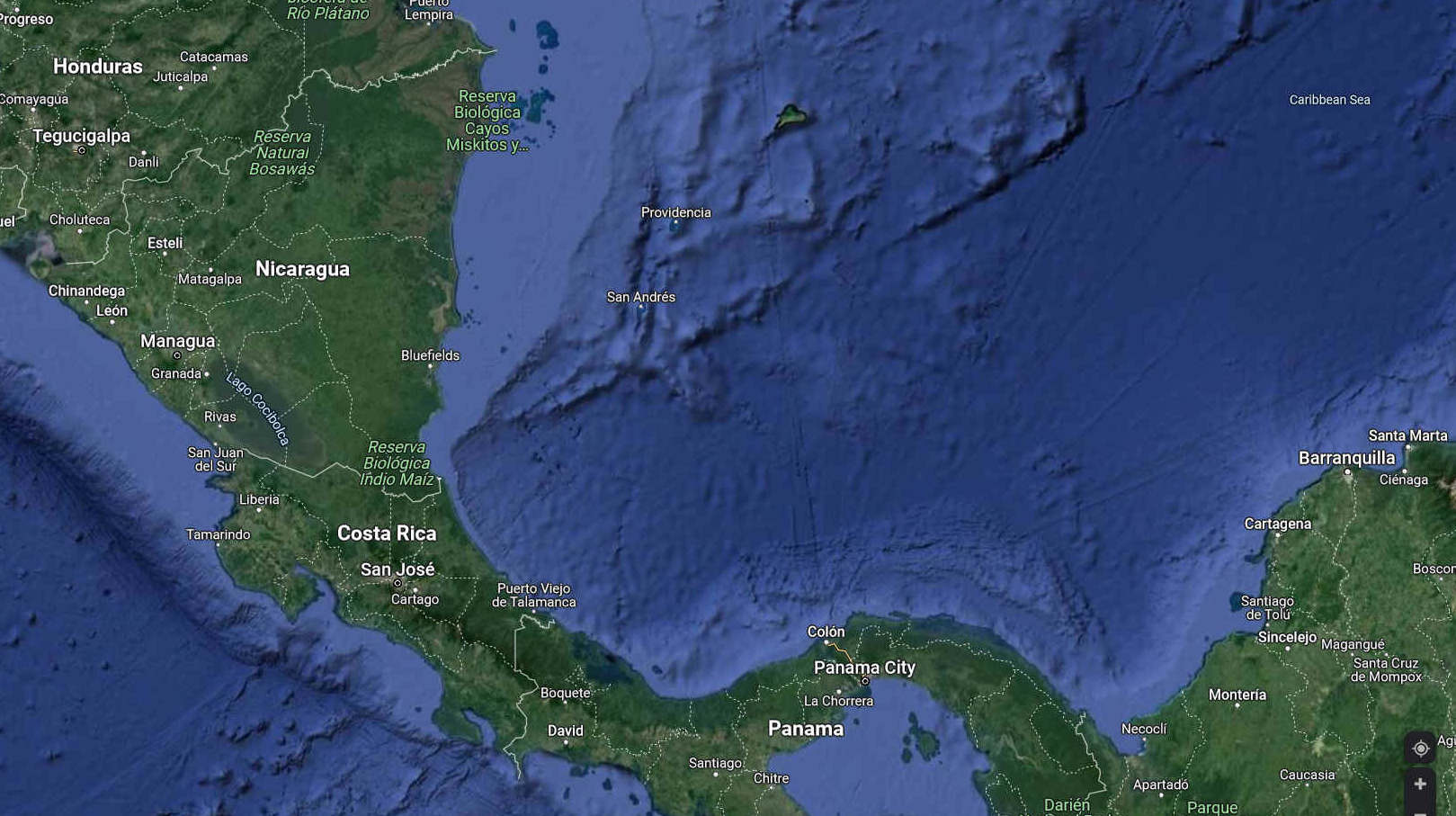
VICEROY
OF NEW SPAIN - The Spanish controlled most of the coast in the area of Old
Providence 300 years ago. The climate suited both Portuguese and Spanish
settlers, working with native American Indians to farm the land.
Unfortunately, when it comes to the Amazon, clearing too much rainforest for
cash crops, helping to raise the temperature of the planet, and also causing
sargassum blooms of millions of tons per year.
CARIBBEAN ISLANDS - WEST INDIES
The region, situated largely on the Caribbean Plate, has more than 700 islands, islets, reefs and cays,
too numerous to search with only one lifetime. Three island arcs delineate the eastern and northern edges of the
Caribbean
Sea: The Greater Antilles to the north, and the Lesser Antilles and Leeward Antilles to the south and east. Together with the nearby Lucayan Archipelago, these island arcs make up the West Indies.
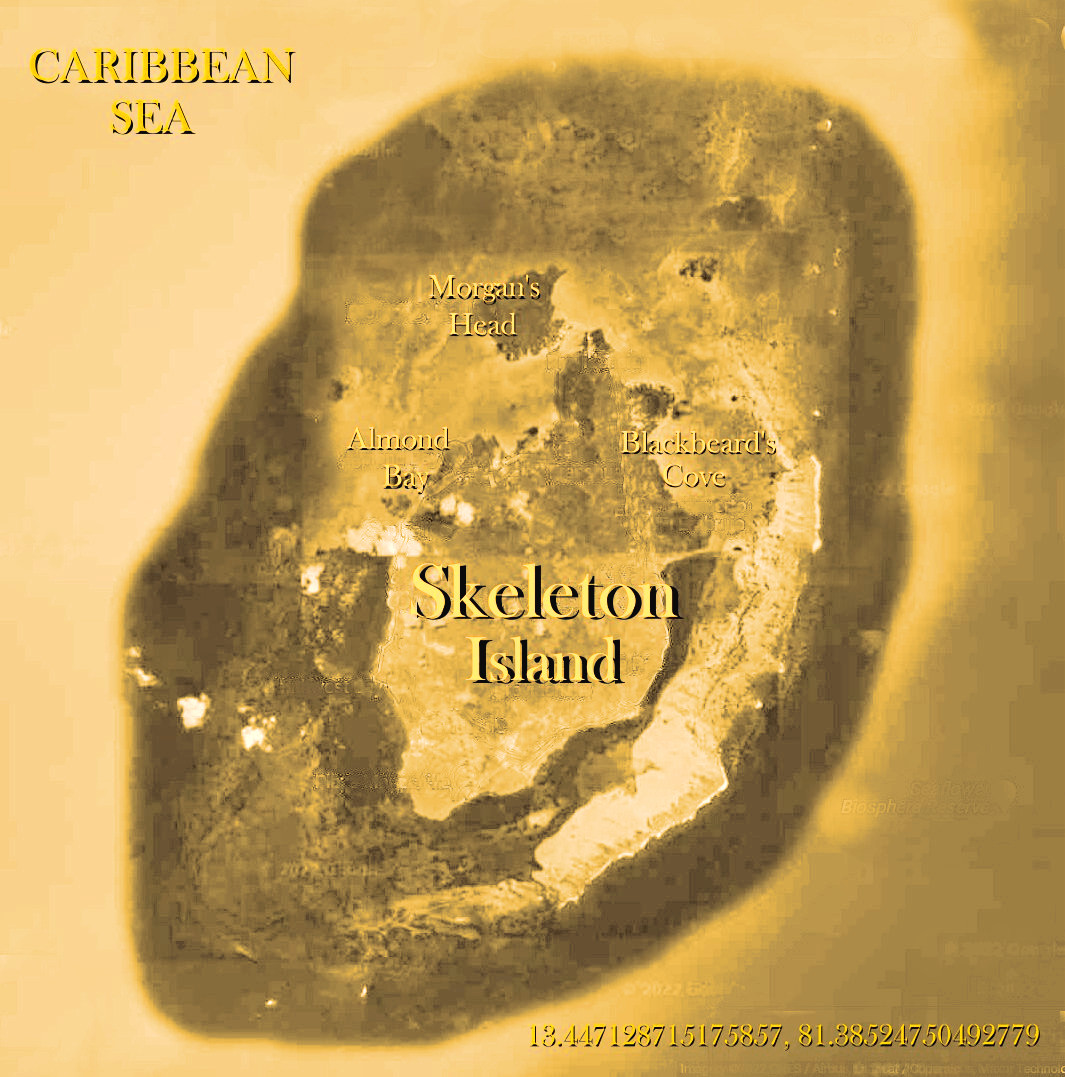
Sir Henry Morgan
visited this island on many occasions, though his plantations were in
Jamaica, and he lived in Port Royal, where he enjoyed the high life. On some
pirate parchments Blackbeard's Cove is marked. On modern maps only Morgan's
Head is acknowledged - simply because Edward Teach did not manage to retire,
pardoned.
ISLA
DE PROVIDENCIA
Isla de Providencia, historically Old Providence, and generally known as Providencia, is a mountainous Caribbean island that is part of the Colombian department of Archipelago of San Andrés, Providencia and Santa Catalina and the municipality of Providencia and Santa Catalina Islands, lying midway between Costa Rica and
Jamaica. Providencia's maximum elevation is 360 metres (1,180 ft) above sea level. The smaller Santa Catalina Island to the northwest is connected by a 100-metre (330 ft) footbridge to its larger sister Providencia Island. Providencia Island has an area of 17 square kilometres (6.6 sq mi); the two islands cover an area of 22 square kilometres (8.5 sq mi) and form the municipality of Santa Isabel, which had a population of 4,927 at the Census of 2005. The island is served by El Embrujo Airport, which the Colombian Government plans to expand in order to take international flights.
The island was the site of an English Puritan colony established in 1629 by the Providence Island Company, and was taken by Spain in 1641.
CAPTAIN HENRY MORGAN
The pirate Henry Morgan used Providencia as a base for raiding the Spanish empire, and rumors suggest that much of his treasure remains hidden on the island. Many parts of the island are named after Morgan. Forts and cannons dating back hundreds of years can be found scattered all over Santa Catalina Island.
WIPE OUT 2020
In November 2020, Hurricane Iota directly impacted the
island, soon after Hurricane Eta. An estimated 98% of all infrastructure was destroyed from the impact, making it one of the worst and strongest tropical cyclones to impact Colombia.
On November 15–16th 2020, Iota passed close to the outlying Archipelago of San Andrés, Providencia and Santa Catalina as a high-end Category 4 hurricane. The center of the hurricane's eye missed Providencia by 11 miles (18 km), but the storm still made a direct hit (rather than a landfall) on the island, causing damage described as "unprecedented" by President Iván Duque Márquez. Communication was lost with the island on November 16, lasting for over 20 hours. An estimated 98–99 percent of structures on the island were damaged or destroyed, including buildings constructed in the 15th century. Every home on the island suffered damage, with 80 percent being destroyed. One person was killed and six were injured on the island. Two shelters were known to have lost their roof before communication was lost. The situation on the island was difficult to ascertain as of November 17, though the island's hospital was assumed destroyed or rendered inoperable. Although debris covered runways at El Embrujo Airport, initially preventing aircraft from arriving or leaving, by November 17 it was operational enough to allow President Duque to visit and assess the damage of the island.
On San Andrés, torrential rains and large swells caused extensive flooding. Seawater rose up to 9.8 ft (3 m). Powerful winds uprooted numerous trees, some of which fell on homes, and several homes lost their roof. Communications with San Andrés were temporarily lost during the storm and approximately 60 percent of the island lost power. Flooding reached a depth of 6 in (15 cm) at the Gustavo Rojas Pinilla International Airport, preventing usage of the runways. One person was killed on the island.
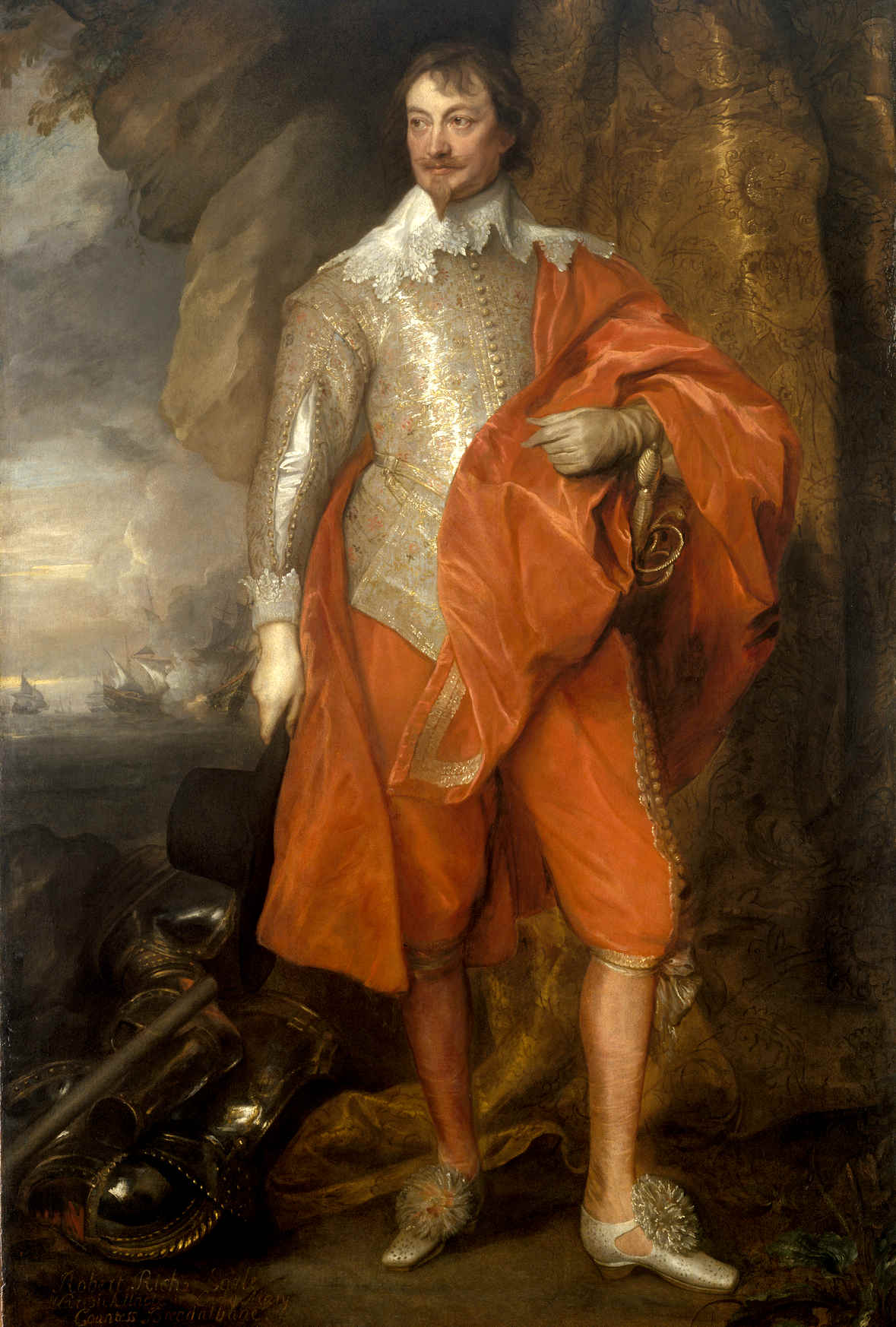
Robert
Rich, Earl of Warwick
COLONIZING PROVIDENCE
The Providence Island colony was established in 1630 by English Puritans on what is now the Colombian Department of San Andrés and Providencia, about 200 kilometres (120 mi) east of the coast of Nicaragua. Although intended to be a model Puritan colony, it also functioned as a base for privateers operating against Spanish ships and settlements in the region. In 1641, the Spanish and Portuguese, after two previous attempts, finally penetrated the harbour's defenses and defeated the English in battle. The Spanish removed all the people but kept the structures. This garrison was maintained on the island, now called Santa Catalina again, until 1666.
The colony was hampered by poor planning, internal strife (seen in conflict among leadership) and economic woes. It was founded, in part, to create a profitable and Godly Puritan base. It was expected to be more profitable and successful than the Massachusetts Bay Colony that was founded in 1630. The colony is known for its involvement in the trade in slaves and was the beginning of the English use of Africans as life-long slaves instead of indentured servants.
Some of the more famous residents were the governors Nathaniel Butler and Philip Bell, Bell's father-in-law Daniel Elfrith, and William Rous. Philip Bell was the first governor and was replaced by Robert Hunt, due to conflict with another colonist. Nathaniel Butler later replaced Hunt. Many of these men had already had experience with England's colonizing and economic expeditions with the Virginia Company and the Somers (Bermuda) Company.
It is possible to infer what life was like on the island based on the accounts of slaves. They reported that some of the Englishmen who wanted to leave said "this place is no way to live" as a complaint against eating
turtles all the time. Life included church services, trade with English ships, and hopes for corsair raids against the Spanish. Tobacco was grown on the island by the African and Native American slaves. The island's freshwater streams and surrounding waters provided fish and turtles as additional food sources. They sometimes brought back Miskito Indians from their expeditions to the mainland of present day Nicaragua.
The principal trading port had several small forts around the harbor and at the bay's entrance. There were about fourteen forts in all.
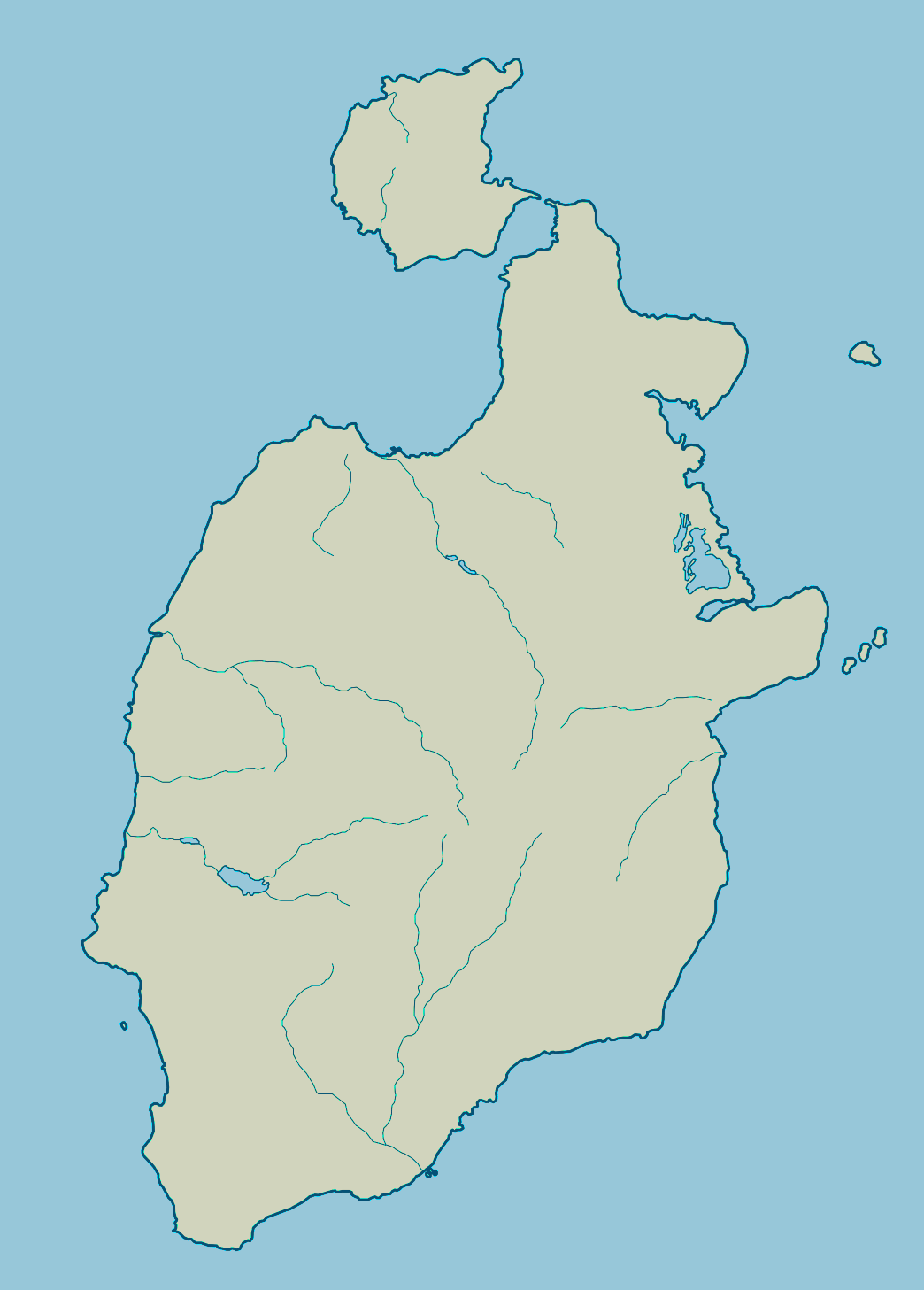
Isla
de Providencia and Santa Catalina island.
ORIGINS OF THE COLONY
The island was first documented on November 25, 1510 by Lope de Olano, a Basque sailing for Castile-Aragon. It remained unsettled and was known to French and Dutch pirates, but apparently was first visited by English ships in 1628. In that year, the Puritan Robert Rich, 2nd Earl of Warwick, sent three privateer ships to the West Indies. They reached San Andrés, to the south of Santa Catalina, and landed thirty men there to plant tobacco for snuff. Sussex Camock, with his bark Warwicke & Somer Islands, remained on San Andreas. Daniel Elfrith returned to England via Bermuda to report the discovery. Elfrith told the governor of Bermuda, his son-in-law Philip Bell, of their findings.
In March 1629, Bell wrote to his cousin Sir Nathaniel Rich announcing the discovery of the two islands. Bell's letter described the island as "lying in the heart of the Indies & the mouth of the Spaniards." Thus it was an excellent base for privateering against the Spanish ships. Bell considered that the island would also provide excellent revenue from tobacco and other crops. Leading members of the company included the Earl of Warwick, his brother Henry Rich, 1st Earl of Holland and their cousin Sir Nathaniel Rich, William Fiennes, Lord Saye and Sele, and Robert Greville, Lord Brooke.
Philip Bell sailed to Providence in 1629, taking several Bermudians with him including whites and blacks. In November 1630 the Providence Island Company decided that Captain Daniel Elfrith was to be Governor until he returned, after which Captain Philip Bell would be sole Governor. Each adventurer (shareholder) was to obtain as many men and boys as were willing to serve, and the good ones were to be shipped next January In February 1631 Captain William Rudyerd was appointed commander of the settlers sailing from England to Providence Island in the Seaflower About eighty Bermudians moved to Providence in 1631. In April 1632 the Company learned that the Seaflower had arrived. Some became involved in religious disputes, and were sent back to Bermuda. In May 1632 the Company instructed the master of the Charity, who was taking another 150 settlers to Providence, that no passengers were to be brought home from Providence without a licence.
COLONIAL LIFE
Until 1635 the Company discouraged planters from bringing their wives and children. To help preserve order, the Company ordered servants and other single people to live in "families". Governor Bell was instructed to "distribute all the Inhabitants into several families whereof one shalbe the Chiefe." This chief was responsible for ensuring his family did their duty and was to lead them in prayer twice a day. The company forbade swearing, drunkenness or profaning the Sabbath, and ordered Bell to "take care that Idelness as the Nurse of all Vice be carefullie eschewed." Bell was instructed to seize and destroy "cards and Dice and Tables" that had been sent to the island. Apart from his moral duties, the instructions that Bell received from the Company in 1631 included arranging lodgings for the minister, preventing men from planting tobacco but making them plant corn, and if possible sugar cane, building houses, a church and fortifications against possible attack by the Spanish.
An important difference between Providence Island and the Massachusetts Bay colony was that the Massachusetts settlement was led by resident gentry, who allowed the colony to evolve towards self-sufficiency, while Providence Island was ruled by absentee grandees who kept the settlers totally dependent on them. The colonists were only tenants, with half their profits going to the investors in the company. With a limited stake in the colony, the colonists were unimaginative about ways to improve it. There was a glut of tobacco on the market. The Chesapeake,
Barbados and St. Kitts colonies were producing far more tobacco and of better quality. The directors tried to encourage the planters to grow other crops such as silk grass, cotton, sugar cane, pomegranates, figs or juniper berries. However, despite a collapse in prices in 1634, the planters still persisted in growing tobacco.
Labour on Providence island was originally undertaken by indentured servants from England, although Bell brought some enslaved Africans from Bermuda. Around 1634–1635 the four-year terms of the indentured servants expired, and planters demanded the right to use black slaves in their place. One colonist, the pastor Samuel Rishworth, spoke out against this practice, saying that Christians should not hold slaves. Bell tried to silence this man on instructions from the Company, so he could not encourage the slaves to seek their freedom from their masters. Specifically, the Company told Bell to, "Condemn Mr. Rishworth's behaviour concerning the negroes who ran away, as indiscreet ("arising, as it seems, from a groundless opinion that Christians may not lawfully keep such persons in a state of servitude, during their strangeness from Christianity") By 1635 there was a population of 500 white men, 40 women, 90 blacks and a few children, scattered across the island. The village of New Westminster had just thirty houses, mostly of
timber. Only the church and the governor's house were of brick. Forty guns were distributed between thirteen forts at different points on the island, making no one point particularly strong.
SPANISH HOSTILITIES
The Spanish did not hear of the Providence Island colony until 1635, when they captured some Englishmen in Portobelo, on the Isthmus of Panama. Francisco de Murga, Governor and Captain General of Cartagena, dispatched Captain Gregorio de Castellar y Mantilla and engineer Juan de Somovilla Texada to destroy the colony. The Spanish fleet anchored outside New Westminster in July 1635, and Castellar sent a messenger to demand the surrender of Providence island. Governor Bell refused. The Spanish launched an attack at a poorly defended point, but were repelled by gunfire from the heights and were forced to retreat "in haste and disorder". The Spanish took prisoners, who told them of the "Ysla de Mosquito" (presumably the Miskito Keys). Castellar and Somovilla were sent back in October 1635 to search for the Mosquito Island, but they were unable to find it.
After the attack, under pressure from the Company, King Charles I of England issued letters of marque to the Providence Island Company on 21 December 1635. These authorized raids on the Spanish in retaliation for a raid that had destroyed the English colony on Tortuga earlier in 1635. The company could in turn issue letters of marque to subcontracting privateers who used the island as a base, for a fee. This soon became an important source of profit. Thus the Company made an agreement with the merchant Maurice Thompson under which Thompson could use the island as a base in return for 20% of the booty.
In March 1636 the Company dispatched Captain Robert Hunt on the Blessing to assume the governorship of what was now viewed as a base for privateering. Various changes were made with Hunt's appointment. His passage and that of his wife and three children was paid, and he received one hundred acres of land with twenty servants to work it, but he was paid no salary. Also, the Company refused to pay for the defence of the island. On the other hand, the colonists were encouraged to engage in privateering, paying the Company one fifth of the value of the
plunder. According to Thomas Gage, talking of the Spanish treasure fleet sailing between Panama and Havana in 1637.
The greatest fear that possessed the Spanish in this voyage, was the Island of Providence ... whence they feared lest some English ships should come against them with great strength. They cursed the English in it, and called the island a den of thieves and pirates, wiching the King of spain would take some course with it, or else that it would prove very prejudicial to the Spaniards, lying near the mouth of the Desaguadero, and so endangering the frigates of Granada, and standing between Portobel and Cartagena, and so threatening the Galeons, and the King's yearly and mighty treasure.
Depredations continued, leading to growing tension between England and Spain, which were still technically at peace. On 11 July 1640 the Spanish Ambassador in London complained again, saying he:
" understands that there is lately brought in at the Isle of Wight by one, Captain James Reskinner [James Reiskimmer], a ship very richly laden with silver, gold,
diamonds, pearls,
jewels, and many other precious commodities taken by him in virtue of a commission of the said Earl [of Warwick] from the subjects of his Catholic Majesty ... to the infinite wrong and dishonour of his Catholic Majesty, to find himself thus injured and violated, and his subjects thus spoiled, robbed, impoverished and murdered in the highest time of peace, league and amity with your Majesty."
Nathaniel Butler was the last full governor of Providence Island, replacing Robert Hunt in 1638. Hunt remained on the island. Butler had formerly been Governor of
Bermuda, where he had caused extensive fortifications to be erected, and he saw fortifying the island as his main task. Butler had shown he could get on with the Puritans in Bermuda. In Providence Island he was less successful in this aspect of his role, and found it hard to put up with the ministers. Butler returned to England in 1640, satisfied that the fortifications were adequate, deputizing the governorship to Captain Andrew Carter.
In 1640, don Melchor de Aguilera, Governor and Captain-General of Cartagena, resolved to remove the intolerable infestation of pirates on the island. Taking advantage of having infantry from Castile and Portugal wintering in his port, he convinced the Count of Castel-Melhor, João Rodrigues de Vasconcelos e Sousa, to commit himself and his other Portuguese generals and ships to the effort. A force of 1000 was assembled including six hundred armed Portuguese and up to 200 Spaniards from the fleet and the presidio, and two hundred black and mulatto militiamen. They were under the overall leadership of Sousa with the land forces led by don Antonio Maldonado y Tejada, the Sergeant Major, in about a dozen ships including six frigates and a galleon. The troops were landed on the island, and a fierce fight ensued. The Portuguese and Spanish were defeated. Four of the prisoners, including the Portuguese Captain João de Ibarra who was to be the intended new governor, voluntarily surrendered to an English officer on the promise that their lives would be spared. However, Captain Andrew Carter, acting Governor of the colony, ordered all thirteen Portuguese and Spanish prisoners to be put to death after they were interrogated. When a few of the Puritan leaders protested against this brutality, Carter sent the four of them home in chains.
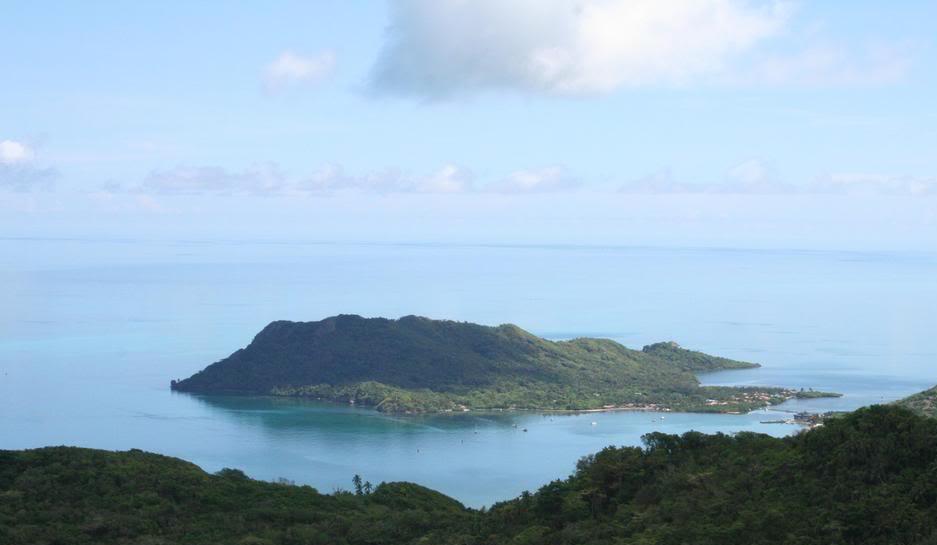
SPANISH CAPTURE OF PROVIDENCE
The Spanish acted decisively to avenge their defeat. General Francisco Díaz Pimienta was given orders by King Philip IV of Spain, Philip III of Portugal, and sailed from Cartagena to Providence with seven large ships, four pinnaces, 1,400 soldiers and 600 seamen, arriving on 19 May 1641. At first Pimienta planned to attack the poorly defended east side, and the English rushed there to improvise defenses. With the winds against him, Pimienta changed plans and made for the main New Westminster harbor. He, along with the Portuguese Count of Castel-Melhor Sousa, personally led the assault on the morning of 24 May. He held back his large ships to avoid damage, and used the pinnaces to attack the forts. The Spanish and Portuguese troops quickly gained control, and once the forts saw the Spanish flag flying over the governor's house, they began negotiations for surrender.
On 25 May 1641, Pimienta and Sousa formally took possession and celebrated mass in the church. The Spanish and Portuguese took sixty guns, and captured the 350 settlers who remained on the island – others had escaped to the Mosquito coast. They took the prisoners to Cartagena. The women and children were given a passage back to England. The Spanish and Portuguese found gold, indigo, cochineal and six hundred black slaves on the island, worth a total of 500,000 ducats, some of the accumulated booty from the English raids. Rather than destroy the defenses, as instructed, Pimienta left a small garrison of 150 men (100 Spanish & 50 Portuguese) to hold the island and prevent occupation by the Dutch. Later that year, Captain John Humphrey, who had been chosen to succeed Captain Butler as governor, arrived with a large group of dissatisfied settlers from New England. He found the Spanish and Portuguese in occupation. Pimienta's decision to occupy the island was approved in 1643 and he was made a knight of the Order of Santiago.
RECAPTURE BY HENRY MORGAN
The island continued to be strategically important as a fertile island with ample water near to the Spanish main. in January 1666 the Dutch privateer Edward Mansvelt, whose fleet included
Henry
Morgan's ship, took the island, known by then as Old Providence. However, the Spanish regained the island just a few months later. In December 1670 Henry Morgan returned to Old Providence, which now had a stone castle, Santa Teresa, and two forts. There were only 190 soldiers, who were overwhelmed by the force of 1,000 buccaneers. Henry Morgan used the island as a base for his raid on Panama in 1670/1671.
PRIVATEERING
Due to the economic difficulties the colonists faced, some turned to privateering to make money. This is surprising to many because it seems in conflict with Puritan values. Though England and Spain were not at war, the desire to protect the respective countries’ interests in the West Indies only increased tensions between the two nations. While Nathaniel Butler was governor, much of his time was spent looking after the needs of privateers. He was hoping to revitalize the colony's hurting economy, which in turn would improve the morale and hopes of the disgruntled colonists. In addition, he was worried that the English and Dutch activity in a heavily Spanish-controlled area would attract unwanted attention.
The island's focus turned to defense and by 1638 the colony expected a Spanish attack within a year. Several men were sent on privateering expeditions themselves and a council of war was created. This is one major difference between the Providence Island colony and other English colonies; as Karen Kupperman observes, in the New England colonies, “success was accompanied by lodging such issues firmly under civilian control. In the threatening world of the western Caribbean, such amateurism was not seen as possible.” However, the privateering expeditions proved unsuccessful due to inexperience and lack of general sailing or West Indies knowledge.
DEMOGRAPHICS & DRUG CARTELS
Although the island is part of Colombia, the 5,000 to 6,000 inhabitants are reported to feel more Caribbean than Colombian, with many Rastafari. The inhabitants mostly speak English or San Andrés–Providencia Creole, an English-based creole similar to Belize Kriol and Jamaican Patwa, rather than the Spanish of Colombia, as well as Provisle, an indigenous sign language.
As of 2015, the island was not seriously affected by the drug trafficking of Colombia, but many islanders were recruited to work for traffickers due to their seafaring skills and knowledge of the waters of the area and to the scarcity of other employment opportunities on the island. It was estimated that about 800 young men out of the island's small population were in jails abroad, or had simply disappeared.
ENVIRONMENT
The 995-hectare national park Old Providence McBean Lagoon is located on the island's northeast side, between Maracaibo and Rocky Point. This National Park consists of coral reefs, small Cayes, mangroves, lagoons and tropical dry forest. The National Park has a tiny visitor centre on Crab Caye, from where there are views towards the barrier reef and the waters that surround the caye.
A local population of black land crabs is noteworthy for its breeding migration, which occurs every April/May. These crabs live in the hills of the island and descend (en masse) to the sea once a year to lay their eggs.
Providencia is the centre point of the UNESCO Marine Protected Area the Seaflower Biosphere Reserve, which forms 10% of the entire
Caribbean
Sea. This ecologically important reserve contains some of the world's greatest marine biodiversity, and incorporates the Archipelago of San Andrés, Providencia and Santa Catalina, in addition to the remote uninhabited cays at Roncador Bank, Serrana Bank, as well as distant reefs that include Quita Sueño Bank, Rosalind Bank and Alice Shoal.
|



